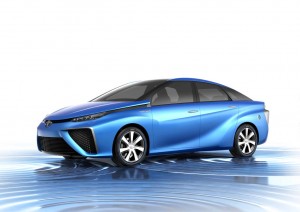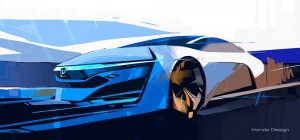Honda plans to provide its “vision for the future of personal mobility” when it unveils its second-generation, hydrogen-powered car, the new FCEV, at the Los Angeles Auto Show next week.
While it today offers a wide range of hybrid, plug-in and full battery-electric vehicles, Honda has been a long-time advocate of fuel-cell technology – which advocates contend offers significant advantages over current battery technology. But it isn’t alone. Toyota and Hyundai have also committed to launching hydrogen cars, with other makers including General Motors developing their own technology.
“The Honda FCEV Concept demonstrates the company’s vision for the future of personal mobility and our commitment to developing advanced alternative fuel vehicles,” said Mike Accavitti, American Honda’s senior vice president, in a statement accompanying this sketch of the FCEV Concept.
In typical form, the Honda prototype is expected to be just a thinly disguised version of the real fuel-cell vehicle Honda is planning to bring to the market in 2015 as part of what Accavitti described as “a zero-emissions future.”

Toyota is planning to introduce its FCV, Fuel Cell Vehicle, during the Tokyo Motor Show later this month. It's expected to go on sale in 2015.
Fuel cells have been described as “refillable batteries.” Hydrogen is pumped through a device called a stack where a membrane covered in platinum and other precious metals causes the gas to combine with oxygen from the air. That generates an electric current that, in turn, can be used to power the same motors found in a battery-electric vehicle. The only thing that comes out of the exhaust of a fuel-cell vehicle, meanwhile, is water vapor.
There are 100s of fuel-cell vehicles running around in various pilot programs around the world but Honda claims the distinction of being the only maker to actually make the technology available on a commercial basis, so far, as part of a pilot retail program it launched in California. The maker claims it has about two dozen of its original FCX Clarity models on the road today.
(Click Herefor a closer look at Toyota’s hydrogen fuel-cell concept.)
The new Honda FCEV is expected to offer critical improvements in a variety of areas. Though the maker is saving details for the L.A. Auto Show unveiling, expect to hear that it has improved overall range between refills, increased performance, and otherwise upgraded the older FCX Clarity’s drivability.
The unveiling of the new Honda hydrogen car will come at the same time Toyota plans to reveal its own fuel-cell vehicle both in Los Angeles and at the simultaneous Tokyo Motor Show. Notably, the bigger of the Japanese makers has said it will boost range to a fill 300 miles, or roughly the same as one could expect from a conventional gasoline car. And Toyota has said its model – also slated for production in 2015 – can refuel in a matter of minutes.
(Hyundai hopes to have a hydrogen car ready by 2014. Click Here for the full story.)
That is, of course, if a motorist can find a place to tank up on the ultra-light gas. The hydrogen infrastructure is currently quite limited – a major problem often cited by skeptics.
But that could change. California lawmakers have enacted measures that could lead to the opening of 100 hydrogen stations by decade’s end. Both Japan and Germany have also taken steps to set up networks of refueling stations.
Ironically, advocates suggest that the basic technologies, primarily the fuel-cell stack, are ready for prime time if the infrastructure can be put in place, with manufacturing costs expected to tumble with volume production.

